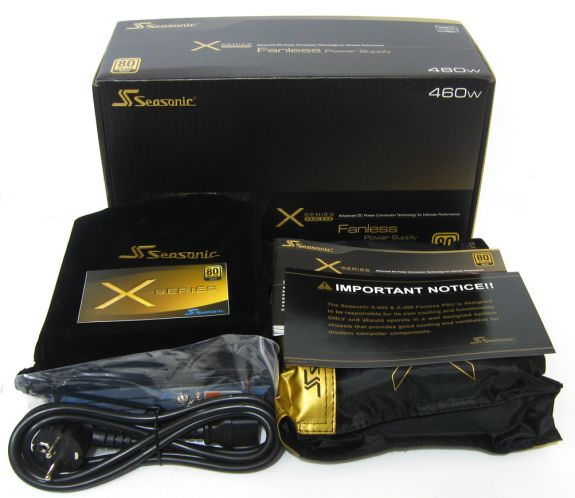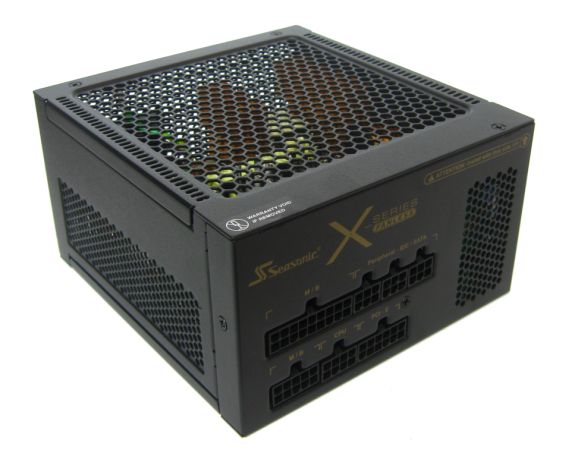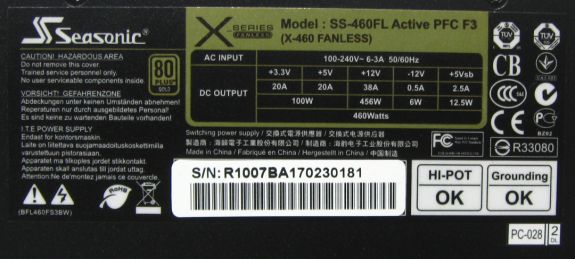Seasonic X-Series SS-460FL: 460 Watts of Fanless Power
by Martin Kaffei on October 20, 2010 12:01 AM EST- Posted in
- Cases/Cooling/PSUs
- Seasonic
- PSUs
- X-460
- Fanless
Package Contents
Seasonic offers a few extras in the package to sweeten the deal. Besides the standard power cable and four screws, you get some stickers, a big user manual, and all the modular cables come in a bag. The "important notice" you can see above states that the PSU "is designed to be responsible for its own cooling". No more, no less.
The X-460FL has a fully-modular connection panel and a description for every plug-type. The main 24-pin cable uses two of the plugs (the large 18-pin connector, and the 6-pin connector next to it).
Rated at up to 456W, the +12V rail can deliver nearly the full power of the PSU. +3.3V and +5V are rated at a maximum capacity of 20A each, with a combined output of 100W. Like most modern high-efficiency power supplies, Seasonic has DC-to-DC converters inside.













41 Comments
View All Comments
Stuka87 - Wednesday, October 20, 2010 - link
This looks like a top notch supply, and I think it would go great in my current system (Antec 300 case). The top fan should easily pull out any heat that is generated. And while my current Antec PSU works fine, its not modular and has a fan (that I can hear). Plus its not as efficient as this PSU (Which is one of the best I have seen).I can see one of these in my future :)
MeanBruce - Wednesday, October 20, 2010 - link
This fan vs fanless argument is really kind of silly! It makes the assumption that all fans are noisy. I consider myself a silent enthusiast, certifiable! We are a crazy bunch, we purchase a new Corsair HX-850 and then break the amazing 7 year warranty by performing a little PSU surgery and changing out the 20db Yan Loot fan for a perfectly silent 6db Noctua NF-S12B ULN or attenuate a larger 140mm Noctua FLX fan down to 8db, and are computing in silent heaven! Normal healthy human breathing generates 10db of sound pressure, so you will not even hear 6 or 8 db even when your desktop is sitting ON your desktop, next to you. For those who work at their pcs and need to hear themselves think, this is a wonderful solution providing substantial cooling to your PSU and in my opinion offering not just silence but absolute quiescence! Bruce out!sinPiEqualsZero - Wednesday, October 20, 2010 - link
I didn't know that people who made costumes would be really into the SS-560KM. Maybe this is a subtle Halloween theme?JarredWalton - Wednesday, October 20, 2010 - link
LOL... just a little ghoulish slip-up on my part.Timewasted - Wednesday, October 20, 2010 - link
The reviewer mentions exercising caution when using this power supply in a typical system, but that's just not warranted. While other fanless power supplies may be designed to be used under ideal situations with plenty of airflow around it, as well as not staying at load for any significant amount of time, the Seasonic units are designed to work exactly as stated.I'd like to point to silentpcreview.com's fanless PSU torture test roundup: http://www.silentpcreview.com/Fanless_PSU_Torture_...
In that article, each of the fanless power supplies is run for 15 hours straight at full load, with the temperature of the air in the "case" reaching 50C+ and no fans to exhaust that heat away from the power supply. The Seasonic power supply performed this test flawlessly, while some of the others had their safety measures kick in, or the power supply just outright died. Sure, this power supply is expensive compared to the alternatives, but you absolutely get your money's worth from it.
MeanBruce - Wednesday, October 20, 2010 - link
So fanless PSUs are more expensive per watt and they are limited to 460 or 560 watts and you have make sure your case adds passive cooling to the unit and lose sleep worrying that the unit still might overheat? I must really be missing the point here, except that PSU manufacturers want to add more units to their product line. I just don't understand how this concept is any kind of solution. You will still hear your 20db case fans and 40db vpu fan. A real solution is to over-heatsink all heat generating components, switch to internal ssd drives and external HDDs for storage, use gold efficiency rated PSUs and replace all stock fans with ultra low noise fans, 8db or less. Some people choose loud components and then add sound proofing to their cases, it's just silly. Start with ultra quiet parts and even full open mesh cases will remain silent. I am really not gettin' this fanless thang at all!earthzero - Wednesday, October 20, 2010 - link
Actually, you don't need any special ventilation for this product. It is so efficient that it doesn't really generate that much heat in real world usage. Most people who get these silent, fanless PSUs already have silent or nearly silent parts. They just want a PSU that can provide more than 150-200w of power without any added noise--with no further modifications necessary. They have a 400W version of this PSU witch would also be more than appropriate for many mid-level gaming rigs (as power consumption for both brands of major gaming cards is coming down in the mid-range every year) that costs $139.00.The name of the game here is efficiency, not "overheatsinking...."
MeanBruce - Thursday, October 21, 2010 - link
Ok here is the low down, the skinny, the dawg’s drawers on this fanless concept. I called a friend of mine who works at Harris Corporation, in Melbourne, Florida. He oversees thermal management for server environments and helped design the computers and electronics for the new Amway Center in Orlando Florida, where the Magic play, the basketball team, there are also bars, shops, and restaurants in the center or centre.He said given two power supplies being equal in every aspect efficiency, output, load, ambient environment, all constant, except one with a closed (psu)case drawing fresh air in “fan-assisted” and pushing the warmed air out the back of the (psu) case, and the other “fanless” with no active cooling relying on heat to simply rise out of the psu into the computer case and then dissipated into the room, the fan assisted power supply would over time move much less heat into the computing environment.
He said the fan-assisted unit would move the warmed air into the computing environment much faster yet that air would be at a much lower temperature.
Whereas the fanless unit would move the warmed air into the pc case and then into the computing environment much slower, that air could be up to twice as warm, double the temperature, since no active air is cooling the power supply components they are allowed to reach a much higher temperature, even though not harming the unit. So over time the computing environment will become much warmer.
With 300 servers to watch out for I am sure this becomes very important and a huge cost consideration. The bottom line it seems is even considering only a single pc, your computing environment will be much warmer with a fanless psu, and much cooler with a fan assisted psu. If you live up north the fanless design might be a benefit. I still think/feel considering environment and acoustics, a fan producing sound that cannot be heard 6db, is a much better solution overall than a fanless design. I guess it just comes down to how many watts you need, what you consider silent, and on what part of the planet you do your computing. Hope this helps.
Bruce out!
Sunburn74 - Wednesday, October 20, 2010 - link
Well... I have a gaming mid tower in my room. Silence is the name of the game. I already have 2 ssds as my drives, a 5850 that at idle is silent, a cpu that idles at 25 degrees with 10 percent fan speed, and acase that encapsulates sound and generates massive airflow with practically no noise. The loudest thing in my box is probably my seasonic x-750w and it generates just alittle too much hum when idling for my tastes. Air exhausted out of the back of case can't really be sound proofed by a case's internals. When I lie in bed talking to my gf, I can hear my psu faintly in the background. Its not annoying. Just.... distressing in a quirky way. I'm like 95% satisfied with the build. 95....Anyway, this power supply is extremely tempting and I assure you, if I do well on a few tests and board exams, I'll probably be shelling out for it as a reward for good behavior.
MeanBruce - Thursday, October 21, 2010 - link
Ok here is the low down, the skinny, the dawg’s drawers on this fanless concept. I called a friend of mine who works at Harris Corporation, in Melbourne, Florida. He oversees thermal management for server environments and helped design the computers and electronics for the new Amway Center in Orlando Florida, where the Magic play, the basketball team, there are also bars, shops, and restaurants in the center or centre.He said given two power supplies being equal in every aspect efficiency, output, load, ambient environment, all constant, except one with a closed (psu)case drawing fresh air in “fan-assisted” and pushing the warmed air out the back of the (psu) case, and the other “fanless” with no active cooling relying on heat to simply rise out of the psu into the computer case and then dissipated into the room, the fan assisted power supply would over time move much less heat into the computing environment.
He said the fan-assisted unit would move the warmed air into the computing environment much faster yet that air would be at a much lower temperature.
Whereas the fanless unit would move the warmed air into the pc case and then into the computing environment much slower, that air could be up to twice as warm, double the temperature, since no active air is cooling the power supply components they are allowed to reach a much higher temperature, even though not harming the unit. So over time the computing environment will become much warmer.
With 300 servers to watch out for I am sure this becomes very important and a huge cost consideration. The bottom line it seems is even considering only a single pc, your computing environment will be much warmer with a fanless psu, and much cooler with a fan assisted psu. If you live up north the fanless design might be a benefit. I still think/feel considering environment and acoustics, a fan producing sound that cannot be heard 6db, is a much better solution overall than a fanless design. I guess it just comes down to how many watts you need, what you consider silent, and on what part of the planet you do your computing. Hope this helps.
Bruce out!